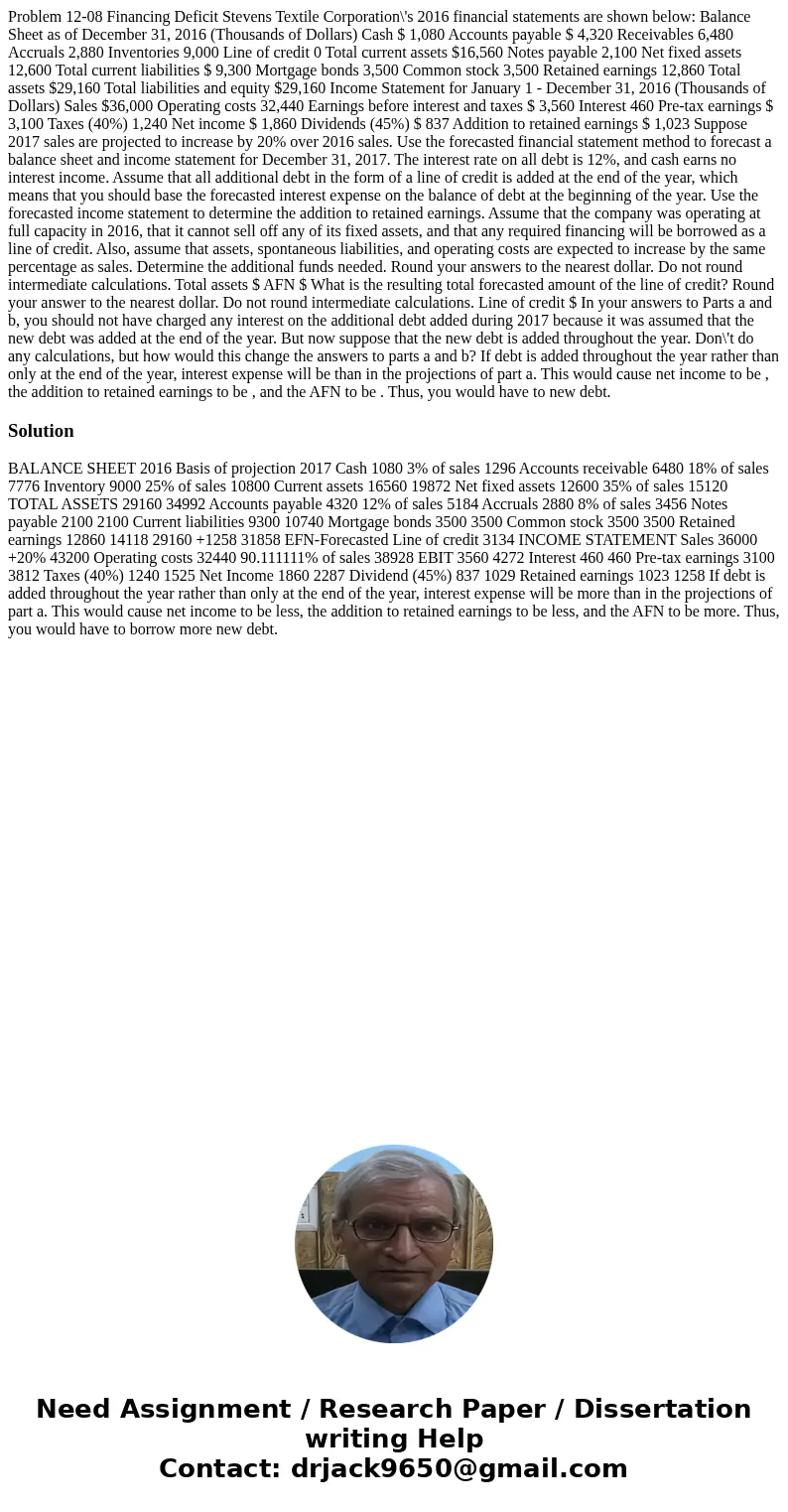Problem 1208 Financing Deficit Stevens Textile Corporations
Problem 12-08 Financing Deficit Stevens Textile Corporation\'s 2016 financial statements are shown below: Balance Sheet as of December 31, 2016 (Thousands of Dollars) Cash $ 1,080 Accounts payable $ 4,320 Receivables 6,480 Accruals 2,880 Inventories 9,000 Line of credit 0 Total current assets $16,560 Notes payable 2,100 Net fixed assets 12,600 Total current liabilities $ 9,300 Mortgage bonds 3,500 Common stock 3,500 Retained earnings 12,860 Total assets $29,160 Total liabilities and equity $29,160 Income Statement for January 1 - December 31, 2016 (Thousands of Dollars) Sales $36,000 Operating costs 32,440 Earnings before interest and taxes $ 3,560 Interest 460 Pre-tax earnings $ 3,100 Taxes (40%) 1,240 Net income $ 1,860 Dividends (45%) $ 837 Addition to retained earnings $ 1,023 Suppose 2017 sales are projected to increase by 20% over 2016 sales. Use the forecasted financial statement method to forecast a balance sheet and income statement for December 31, 2017. The interest rate on all debt is 12%, and cash earns no interest income. Assume that all additional debt in the form of a line of credit is added at the end of the year, which means that you should base the forecasted interest expense on the balance of debt at the beginning of the year. Use the forecasted income statement to determine the addition to retained earnings. Assume that the company was operating at full capacity in 2016, that it cannot sell off any of its fixed assets, and that any required financing will be borrowed as a line of credit. Also, assume that assets, spontaneous liabilities, and operating costs are expected to increase by the same percentage as sales. Determine the additional funds needed. Round your answers to the nearest dollar. Do not round intermediate calculations. Total assets $ AFN $ What is the resulting total forecasted amount of the line of credit? Round your answer to the nearest dollar. Do not round intermediate calculations. Line of credit $ In your answers to Parts a and b, you should not have charged any interest on the additional debt added during 2017 because it was assumed that the new debt was added at the end of the year. But now suppose that the new debt is added throughout the year. Don\'t do any calculations, but how would this change the answers to parts a and b? If debt is added throughout the year rather than only at the end of the year, interest expense will be than in the projections of part a. This would cause net income to be , the addition to retained earnings to be , and the AFN to be . Thus, you would have to new debt.
Solution
BALANCE SHEET 2016 Basis of projection 2017 Cash 1080 3% of sales 1296 Accounts receivable 6480 18% of sales 7776 Inventory 9000 25% of sales 10800 Current assets 16560 19872 Net fixed assets 12600 35% of sales 15120 TOTAL ASSETS 29160 34992 Accounts payable 4320 12% of sales 5184 Accruals 2880 8% of sales 3456 Notes payable 2100 2100 Current liabilities 9300 10740 Mortgage bonds 3500 3500 Common stock 3500 3500 Retained earnings 12860 14118 29160 +1258 31858 EFN-Forecasted Line of credit 3134 INCOME STATEMENT Sales 36000 +20% 43200 Operating costs 32440 90.111111% of sales 38928 EBIT 3560 4272 Interest 460 460 Pre-tax earnings 3100 3812 Taxes (40%) 1240 1525 Net Income 1860 2287 Dividend (45%) 837 1029 Retained earnings 1023 1258 If debt is added throughout the year rather than only at the end of the year, interest expense will be more than in the projections of part a. This would cause net income to be less, the addition to retained earnings to be less, and the AFN to be more. Thus, you would have to borrow more new debt.
 Homework Sourse
Homework Sourse